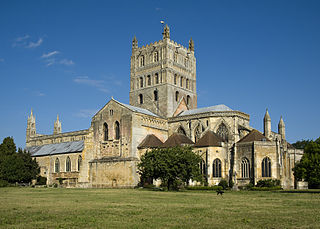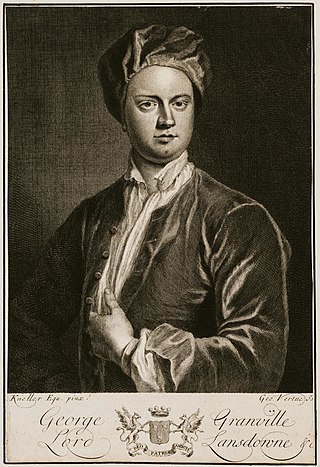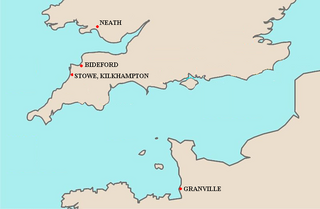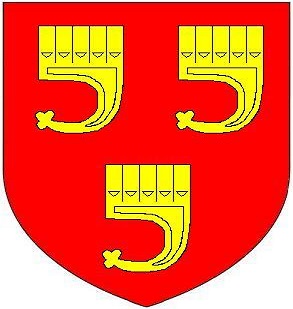
The Abbey Church of St Mary the Virgin, Tewkesbury, commonly known as Tewkesbury Abbey, is located in the town of Tewkesbury in the ceremonial county of Gloucestershire, England. A former Benedictine monastery, it is now a parish church. Considered one of the finest examples of Norman architecture in Britain, it has the largest Romanesque crossing tower in Europe.

Robert FitzRoy, 1st Earl of Gloucester was an illegitimate son of King Henry I of England. He was the half-brother of the Empress Matilda, and her chief military supporter during the civil war known as the Anarchy, in which she vied with Stephen of Blois for the throne of England.

William FitzRobert, 2nd Earl of Gloucester was the son and heir of Sir Robert de Caen, 1st Earl of Gloucester, and Mabel FitzRobert of Gloucester, daughter of Robert Fitzhamon, and nephew of Empress Matilda.

George Granville, 1st Baron Lansdowne PC, of Stowe, Cornwall, was an English Tory politician who sat in the English and British House of Commons from 1702 until 1712, when he was raised to the peerage as Baron Lansdown and sat in the House of Lords. He was Secretary at War during the Harley administration from 1710 to 1712. He was also a noted poet and made a name for himself with verses composed on the visit of Mary of Modena, then Duchess of York, while he was at Cambridge in 1677. He was also a playwright, following in the style of John Dryden.

Bernard de Neufmarché, also Bernard of Newmarket or Bernard of Newmarch was the first of the Norman conquerors of Wales. He was a minor Norman lord who rose to power in the Welsh Marches before successfully undertaking the invasion and conquest of the Kingdom of Brycheiniog between 1088 and 1095. Out of the ruins of the Welsh kingdom he created the Anglo-Norman lordship of Brecon.

Robert Fitzharding was an Anglo-Saxon nobleman from Bristol who was granted the feudal barony of Berkeley in Gloucestershire. He rebuilt Berkeley Castle, and founded the Berkeley family which still occupies it today. He was a wealthy Bristol merchant and a financier of the future King Henry II of England (1133-1189) in the period known as the Anarchy during which Henry's mother, the Empress Matilda (1102-1167), mounted repeated military challenges to King Stephen. Fitzharding founded St. Augustine's Abbey, which after the Reformation became Bristol Cathedral. Many members of the Berkeley family were buried within it, and some of their effigies survive there. As J. Horace Round asserted he was one of the very few Anglo-Saxon noblemen who managed to retain their noble status in Norman England and successfully integrate with the Norman nobility, if not the only one.

The Lordship of Glamorgan was one of the most powerful and wealthy of the Welsh Marcher Lordships. The seat was Cardiff Castle. It was established by the conquest of Glamorgan from its native Welsh ruler, by the Anglo-Norman nobleman Robert FitzHamon, feudal baron of Gloucester, and his legendary followers the Twelve Knights of Glamorgan. The Anglo-Norman Lord of Glamorgan, like all Marcher lords, ruled his lands directly by his own law: thus he could, amongst other things, declare war, raise taxes, establish courts and markets and build castles as he wished, without reference to the Crown. These privileges were only lost under the Laws in Wales Acts 1535–1542. Though possessing many castles, the main seat of the Lordship was Cardiff Castle.
Maud of Gloucester, Countess of Chester, also known as Matilda, was an Anglo-Norman noblewoman and the daughter of Robert, 1st Earl of Gloucester, an illegitimate son of King Henry I of England, and Mabel, daughter and heiress of Robert Fitzhamon. Her husband was Ranulf de Gernon, 4th Earl of Chester.
Mabel FitzRobert, Countess of Gloucester was an Anglo-Norman noblewoman, and a wealthy heiress who brought the lordship of Gloucester, among other prestigious honours to her husband, Robert, 1st Earl of Gloucester upon their marriage. He was the illegitimate son of King Henry I of England.
Hamo Dapifer was an Anglo-Norman royal official under both King William I of England and his son King William II of England. He held the office, from which his epithet derives, known in Latin as dapifer and in French seneschal, in English "steward", as well as the office of Sheriff of Kent.
The Twelve Knights of Glamorgan were a "legendary" group of mercenaries who followed Robert Fitzhamon (d.1107), the Norman conqueror of Glamorgan. Although Fitzhamon was an actual historical figure, 16th-century historians, in particular Sir Edward Stradling, built upon the legend of a group of knights who ruled over the county in his stead. The fact that many of the knights existed during the period gave the legend credence.

Newcastle Castle is a medieval castle located on Newcastle Hill, Newcastle, overlooking the town centre of Bridgend in Glamorgan, South Wales. It was originally believed to date from 1106 when a ringwork was created at the site by the Norman baron Robert Fitzhamon. Some of the fine stonework survives, but today the castle is ruinous.
Milo de Cogan was an Anglo-Norman knight from Glamorgan who played a significant role in the Norman conquest of Ireland under Richard de Clare, 2nd Earl of Pembroke; a man better known to Irish history as Strongbow.
Brictric was a powerful English thane whose many English landholdings, mostly in the West Country, are recorded in the Domesday Book of 1086.

Hamon Dentatus was a Norman baron who was killed while rebelling with other Norman barons against William II, Duke of Normandy at the Battle of Val-ès-Dunes. The epithet "Dentatus" or "Dens" was probably given to Hamon because he was born with teeth. Little is known about Hamon's life.
The feudal barony of Gloucester or Honour of Gloucester was one of the largest of the mediaeval English feudal baronies in 1166, comprising 279 knight's fees, or manors. The constituent landholdings were spread over many counties. The location of the caput at Gloucester is not certain as Gloucester Castle appears to have been a royal castle, but it is known that the baronial court was held at Bristol in Gloucestershire.

Sir Richard de Grenville was one of the Twelve Knights of Glamorgan who served under Robert FitzHamon, in the conquest of Glamorgan in Wales. He obtained from FitzHamon the lordship of Neath in which he built Neath Castle and in 1129 founded Neath Abbey. He is by tradition the founder and ancestor of the prominent Westcountry Grenville family of Stowe in the parish of Kilkhampton in Cornwall and of Bideford in Devon, the later head of which family was John Granville, 1st Earl of Bath (1628–1701). The surname of his supposed descendants the Westcountry Grenville family was spelled by tradition "Grenville" until 1661 when it was altered to "Granville".

The manor of Bideford in North Devon was held by the Grenville family between the 12th and 18th centuries. The full descent is as follows:

Richard Grenville lord of the manor of Stowe, Kilkhampton in Cornwall and of Bideford in Devon, was an English soldier, politician, and administrator who served as a Member of Parliament for Cornwall in 1529, and served as Sheriff of Cornwall and Sheriff of Devon.

Bernard Granville of Birdcage Walk, Westminster, and Apps Court, Walton-on-Thames, Surrey, a member of an ancient and prominent Westcountry family, was a courtier of King Charles II who served as a Member of Parliament for several Cornish constituencies.











